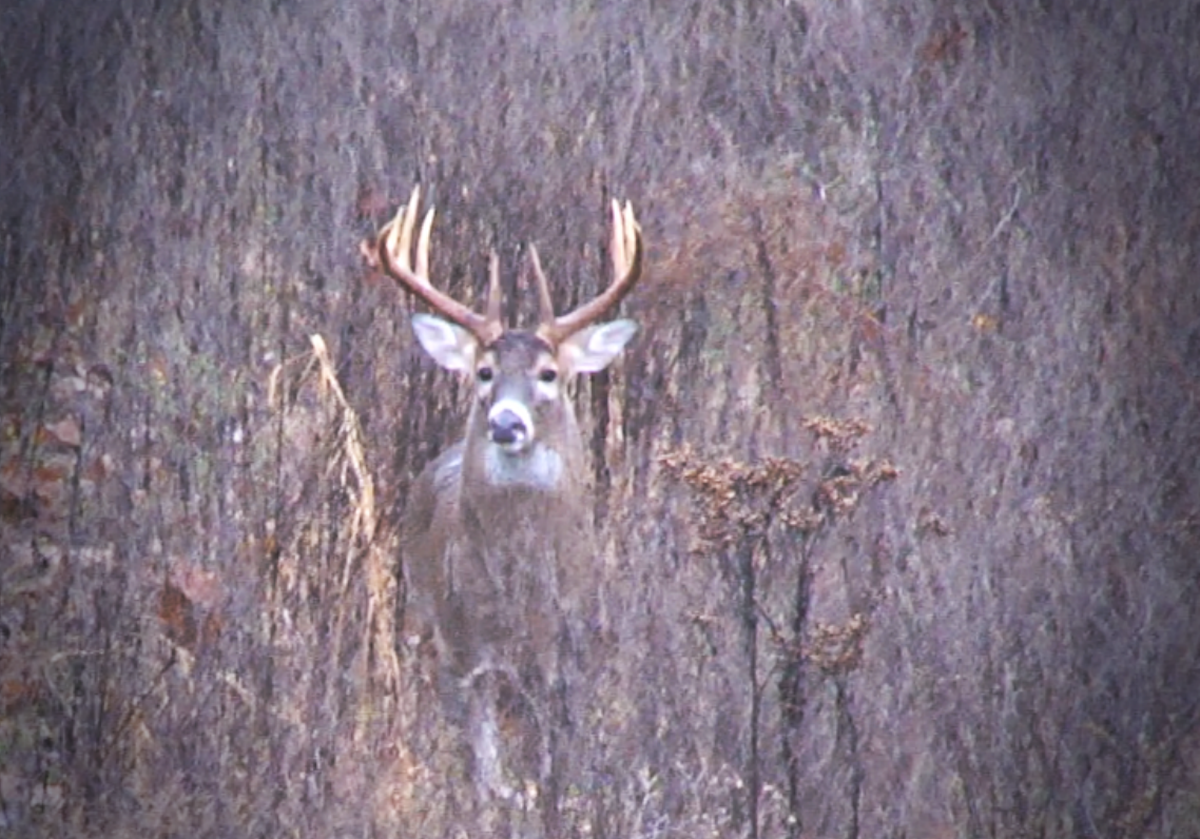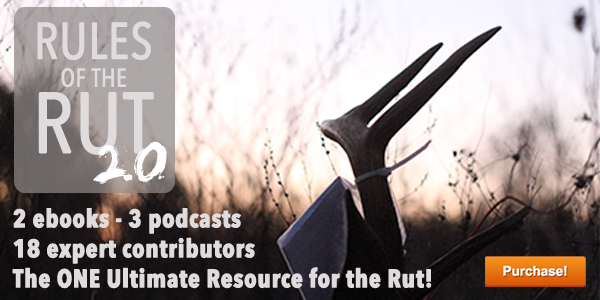
By Mark Kenyon
The alarm pierced the silence like a rusty butter knife cutting through a metal trash bin.
What in the world could possess someone to do this? Even though I was purposely waking up at 3:15 AM to head out to a tree stand , I still wasn’t quite sure if this was sane. But about five hours later, as I hit my grunt tube twice and watched a wide and heavy horned whitetail head my way, I knew I had made the right decision. The rut was popping and all the late nights, early mornings and long days were worth it. Because when the rut is on, there’s nothing better.
That said, it sometimes can be tough to determine when exactly the rut will be “on”! Today we’re continuing our annual tradition of discussing rut predictions for the upcoming fall. Understanding the expected timing of the rut is of course important, as many of us plan our vacations and whitetail adventures around the rut each fall. Get the timing wrong and you might end up sitting in the tree for five days twiddling your thumbs. Get it right and you’ll be watching a steady parade of bucks cruising and chasing does and you’ll maybe even put a big one on the ground.
With that goal in mind, today we’re sharing the annual rut predictions from several different sources. First, we’ll explore the popular lunar rut predictions from Charles Alsheimer and Wayne Laroche, and then we’ll discuss the more traditional views of the timing of the rut. Finally, we close things out with my own two cents on the topic. So settle in, read on and get ready to request some vacation days for November!
NOTE: If you’re interested in more rut hunting info after reading through these predictions, be sure to check out our “Rules of the Rut 2.0” eBooks and Podcasts, featuring top whitetail experts from Field & Stream, Outdoor Life, North American Whitetail, Deer & Deer Hunting Magazine, and more!
Wayne Laroche/Charles Alsheimer Lunar 2014 Rut Predictions
As many of you know, each year Deer & Deer Hunting’s Charles Alsheimer releases a series of rut predictions based on a lunar calendar. Today, we’ll be sharing the first phase of these rut predictions – those being the basics of what Alsheimer’s Lunar Calendar predicts for the 2014 rut.
But first – lets recap the basis for these predictions. Alsheimer and wildlife biologist Wayne Laroche have been studying the timing of the rut for nearly 20 years now and these predictions are based on their findings. According to Deer & Deer Hunting’s 2014 Whitetail Calendar and Rut Predictions, “The rut predictor is based on a model that links cyclical changes in the Earth’s solar and lunar illumination to the whitetail’s reproductive cycle. Wayne and Alsheimer hypothesize that sunlight and moonlight provide environmental cues that set, trigger and synchronize breeding.”
Ultimately, according to this theory the second full moon after the autumn equinox is believed to trigger the peak in rutting activity, and Wayne and Alsheimer’s predictions revolve around this “Rutting Moon”.
So that said – when does the “Rutting Moon” hit this year and what will that mean for rutting activity in 2014?
***
This year the “Rutting Moon” is much earlier than last year, falling on November 6. That’s compared to the especially late “Rutting Moon” in 2013, falling on November 17th. This late moon, according to Laroche/Alsheimer, resulted in a “trickle rut” with most rutting activity happening later than usual (third or fourth weeks in November), with other peaks and valleys occurring sporadically over late October and mid November. This “trickle rut” usually ends up resulting in spotty rut activity, and below average hunting success. From what I saw and heard from a lot of hunters this year, the 2013 rut was definitely less than stellar – seemingly in line with what was predicted (Click here to read more about 2013 rut observations).
So what does this November 6th “Rutting Moon” mean for the rut in 2014? Well, according to this theory, this would mean that the majority of rutting behavior should be earlier than last year, more intense, and more in line with the “typical” whitetail rut we’re used to seeing.
According to Alsheimer’s Lunar Calendar, major “seeking” behavior should pick up around October 30th and continue until around November 6th, when major “chasing” should begin. This wild rutting frenzy will continue until around November 14th when the “tending” phase should be beginning and the “lockdown” period will follow shortly.
So what does this mean for hunters? If you tend to believe these predictions, it would mean that the typical “prime time” of the first week or two of November should be, as usual, the best time to be in the woods! According to this prediction, October 30 – November 13th should be some of the best hunting of the entire season, when the most seeking and chasing will be happening, which is in fact the “rutting behavior” that hunters are most interested in seeing.
The Traditional View on Rut Prediction Theories
On the other side of the aisle, when it comes to rut timing theories, many other biologists and whitetail experts believe that the timing of the rut is NOT variable nor impacted by lunar factors (excluding some Southern US regions – where rut timing is very scattered). In fact, according to many studies, the actual peak of breeding appears to be consistent year after year.
According to a recent publication from The Quality Deer Management Association, “The bottom line is northern whitetails have a narrow breeding window to optimize doe and fawn health and survival. This is why numerous studies across the northern United States and Canada looking at conception dates show very little year-to-year variation. In fact, these breeding dates are amazingly consistent from year to year – regardless of moon phase, weather patterns, or other variables.”
Expanding on this point, QDMA Director of Communications Lindsay Thomas Jr explains “The science on this is decisive. A significant number of scientific, peer-reviewed studies have shown the timing of the rut in any particular location is triggered by photoperiod, or day length – not by the moon, or temperature, or anything else…I think hunters often confuse visible rut behaviors, like chasing and grunting, with the peak of breeding. When you document breeding dates in a location, they actually change very little year to year, even though the dates of peak rut behaviors might vary. That’s because weather, moon phase and food sources – things that fluctuate widely year to year – affect deer movement patterns. But even when the weather reduces deer movement, you find that breeding still takes place the same time it normally does. If a doe is coming into estrous, a warm front isn’t going to change that.”
Bill Winke of MidwestWhitetail.com seems to concur, as he is quoted saying” “I have not seen a rut predictor that was actually more accurate than the calendar. The rut is triggered by photoperiod – the amount of sunlight (number of hours) in each day. As the season progresses, that triggers the rut at pretty much the same time every year. You may see more behavior on certain days than others related to weather or hunting pressure, but the actual conception dates of the does are pretty consistent from year to year. Missouri recently did a study back-dating fetuses from late season harvested does and they proved that over a three year period the peak breeding date (the date when the most does were in estrous) was November 15 plus or minus one day. I always like to hunt during the week that starts ten days before the peak. In this case November 5 – 12. It is tough to beat that time frame. ”
Rut Timing In The South
Timing the rut South of the Mason-Dixon line seems to be a whole nother can of worms and much more variable. According to Alsheimer, “Southern whitetails don’t face the harsh winters and brutal conditions that dictate when Northern whitetail fawns must be born to ensure they are large enough to survive severe winters. Harsh cold and deep snows aren’t part of the Southern equation, so weather isn’t a factor for fawn births. Therefore, the South’s rut appears to be driven by less obvious factors, such as climate, genetics, nutrition, day length, moon phases and doe-to-buck ratios…It’s crucial to check with a local biologist to find out what month the rut typically occurs at a specific location.”
My Own Opinion On The Rut Prediction Theories
So, with all of these various opinions on the matter out of the way, lets discuss my own personal views on the timing of the rut.
First, regarding Laroche’s/Alsheiemer’s predictions, over the past four years my own personal observations have matched up – to a degree – with these predictions. In 2010 and 2013, when a “trickle rut” was predicted, I saw noticeably less daylight rutting activity (seeking/chasing) and the activity I did see seemed to be much more sporadic and spread out. In 2011 and 2012, when a more typical rut was predicted, I saw a more concentrated and intense amount of rutting activity during the first few weeks of November.
That said, in all four years, I still did see the majority of rutting activity happening in late October and the first two weeks of November – but it did vary a bit, as mentioned. Given these observations, I think there is probably something to the lunar theory that Laroche/Alsheimer have put together. But, in general, I fall more into the camp that stands with the scientific studies indicating a consistent timing of the breeding cycle – regardless of moon.
As the studies have repeatedly shown, fetus tests indicate that the majority of breeding (in the North) almost always occurs around November 15th, regardless of moon or other factors. This would mean that, typically, most seeking and chasing will be occurring during the week or two preceding that date. My current hypothesis is that this November 15th peak breeding date holds true, and that the two preceding weeks will almost always be the “peak” of rutting behavior (seeking/chasing). But, factors such as the moon cycle may impact the visible intensity of that activity – especially during the day.
I’ll still be focusing my heaviest hunting efforts on the first two weeks of November, no matter what the lunar theory predictions indicate. That said, I do still like to see the lunar theory matching up with that two week window – as I think this is the best possible scenario.
Photoperiod and lunar triggers seem to be in line to set off a terrific rut in 2014 – and I can’t wait!
What Are Your Thoughts?
Now we want to know what you think!
So what are your thoughts? Are you a believer in Laroche and Alsheimers theory or not? What determines your rut hunting vacation dates – the lunar theory or the dates on the calendar?
If you’re interested, check out the links below to the rut prediction articles from the past four years and see how they compare to your actual observations. Then let us know in the comments what your thoughts are…
If you’re interested in learning more about Laroche and Alsheimer’s Lunar Rut Theory – pick up a copy of Deer & Deer Hunting’s Whitetail Calendar which includes the full rut predictions.
Finally, if you’d like more rut hunting information, download our “Rules of the Rut 2.0” eBook and Podcast package, which includes two 100% rut focused eBooks and three downloadable podcasts featuring contributors from Field & Stream, Outdoor Life, North American Whitetail, Deer & Deer Hunting and more! More information can be found at the link below…






Conversation